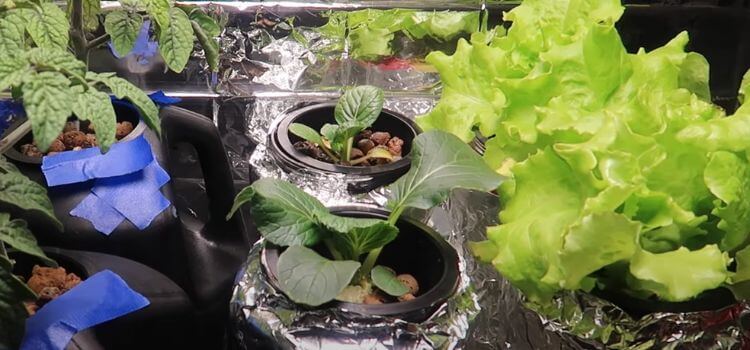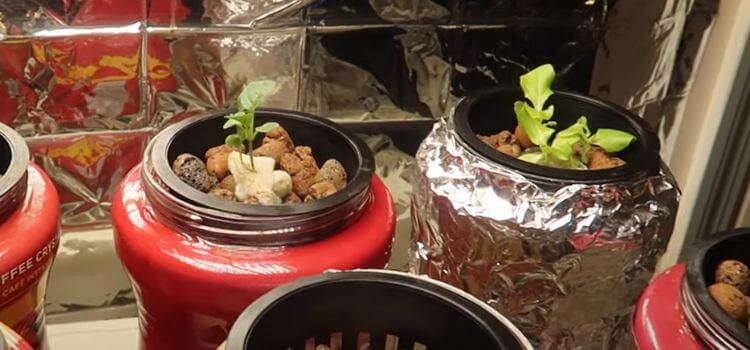As an Amazon Associate, I earn from qualifying purchases.
Hydroponics is an incredibly efficient way to grow plants, allowing you to produce more with less effort and resources. This gardening strategy’s faster growth rates and larger yields make it popular.
However, one common challenge many hydroponic gardeners face is finding suitable materials for germinating seeds. But before you can reap the rewards of hydroponics, you must germinate your seeds. If you’re looking for a way to grow seeds for hydroponics without using rock wool, you’ve come to the right place.
In this post, we’ll walk you through germinating seeds for hydroponics without any rockwool. We’ll cover the materials you’ll need, the steps you’ll need, and the benefits of germinating seeds without rockwool. Let’s get started!
Why is Germinating Seeds Important?
Before we dive into the alternatives to rockwool, let’s first understand why germinating seeds is essential in hydroponics.
Germination is the process of a seed sprouting and developing into a seedling. Hydroponics requires this stage to build the plant’s root system before transplanting it into a more extensive system.
Healthy plant growth depends on successful germination, which can make or break your hydroponic garden. Therefore, choosing suitable materials and methods for germinating seeds is crucial.
Alternatives to Rockwool
While rockwool has been a popular choice for germinating seeds in hydroponics, several alternatives can be just as effective. Here are some of the most commonly used options:
- Peat Pellets: These small discs expand when watered from compressed peat moss, providing an excellent substrate for germinating seeds.
- Vermiculite: This natural mineral can hold moisture and nutrients, making it suitable for germination.
- Cocopeat: Also known as coconut coir, this is a by-product of coconut processing and has excellent water retention properties.
These alternatives are more cost-effective and readily available compared to rockwool. Plus, they also offer better drainage and aeration for seed germination.

Easy Steps for Germinating Seeds in Hydroponics
One essential part of hydroponics is seed germination. Growing a plant from a seed is necessary for your hydroponic garden’s success.
Traditionally, rockwool has been used as the medium for seed germination in hydroponics.
However, eco-friendly alternatives that can be just as effective are now available. Here is a step-by-step guide for germinating seeds in a hydroponic system:
Step 1: Choose the Right Seeds
The first step is choosing the plant type you want to grow. Make sure you select good-quality seeds that have been collected from healthy plants.
Avoid unfamiliar seeds since they may be contaminated with fungus or bacteria, preventing germination. Go for seeds grown explicitly for hydroponics, as they are designed to be compatible with all hydroponic systems.
Also, purchase the correct number of seeds, as you want to have a manageable number. Once you have the right number of seeds, you can germinate them without rockwool.
Step 2: Prepare the Growing Medium
The next step is to prepare the germination medium. Instead of rock wool, consider using an eco-friendly alternative such as coconut coir, peat moss, or vermiculite. These can be just as effective and are more sustainable options.
Soak the medium
Once the medium is ready, you can soak the seeds in it for a few hours to help them to germinate faster. After the seeds have been washed, transfer them to your hydroponic system.
Monitoring
You must monitor the water’s temperature, humidity, and pH levels to ensure the seeds germinate properly. Once the seeds have sprouted, you can enjoy the advantages of hydroponic gardening.
Step 3: Soak the medium
Once you have chosen your medium, soak it in water until it is fully saturated.
Step 4: Plant the Seeds
After the seeds have been soaked, transferring them to the hydroponic system is essential. This is best done using sterile tweezers or another tool, such as a spoon, to avoid contamination. Follow these steps:
Place the seeds
Set your seeds on top of the medium, ensuring they are well-spaced.
Cover with a humidity dome.
This will help create a humid environment for your seeds to germinate.
Provide light and warmth.
Seeds need light and warmth to germinate, so place them in a warm and well-lit area.
Step 5: Water and Monitor the Seeds
Keep an eye on your seeds, ensuring they stay moist but not soggy. Depending on the type of plant, you may need to adjust the amount of water given. It is an essential step in hydroponic gardening. This means you need to monitor the water’s temperature, humidity, and pH levels in the system. These factors must be ideal for the seeds to germinate and grow properly.
Transplant the Germinated Seeds
As your plants mature and their roots become established, it is time to transplant the germinated seeds. Carefully transplant your seeds into your hydroponic system once they have sprouted, following proper spacing guidelines.
Monitor and maintain
Once the plants have been transplanted, it is essential to monitor the environment closely. Keep an eye on your plants as they grow in the hydroponic system. Make sure to provide proper nutrients and adjust any environmental factors as needed.
Benefits of Using Eco-Friendly Alternatives
There are several benefits to using eco-friendly alternatives to rockwool for hydroponic seed germination:
- Sustainability: As mentioned, traditional rock wool is not a sustainable option. By using eco-friendly alternatives, you can reduce your environmental impact.
- Cost-effective: Some eco-friendly alternatives may be more cost-effective than Rockwool.
- Better for plant growth: Many alternative mediums have better water retention and drainage properties, leading to healthier plant growth.
- Reduces waste: Eco-friendly alternatives can be reused or composted, reducing waste produced in your hydroponic garden.
You may grow hydroponic seeds without Rockwool by following these methods and utilizing eco-friendly alternatives.
FAQ On How to Germinate Seeds for Hydroponics Without Rockwool
The steps for growing seeds without rock wool are relatively simple. First, soak the seeds in water for 12 to 24 hours. Then, put the seeds in a tray with a growing medium, like perlite or vermiculite. After that, put the tray somewhere warm and cover it with plastic wrap or a humidity cap. Finally, you must keep the medium moist and wait for the seeds to germinate.
The perfect temperature for germination is between 70 and 80 degrees Fahrenheit.
It would help if you wet the seeds as often as necessary to keep the medium moist. You want the medium to be dry enough to cause the seeds to rot.
Perlite and vermiculite are two of the most common types of soil used to grow plants. They both provide good drainage and aeration essential for successful germination.
The best way to transplant the seedlings is to remove them from the growing medium gently and put them in individual pots. Make sure to use a potting mix that is specifically designed for hydroponics.
Conclusion
Germinating seeds is an essential step in hydroponics, and with these cost-effective alternatives to rock wool, you can easily set your plants up for success.
You need to ensure you have the right conditions and materials available to ensure the success of your seed germination.
By providing your seeds with the right temperature, moisture, and oxygen, you can ensure that your seeds will germinate and grow healthy.
Once you have your germinated seeds, you can move them into your hydroponic system. Your plants will grow and thrive in your hydroponic system with the right combination of nutrients and light.

